

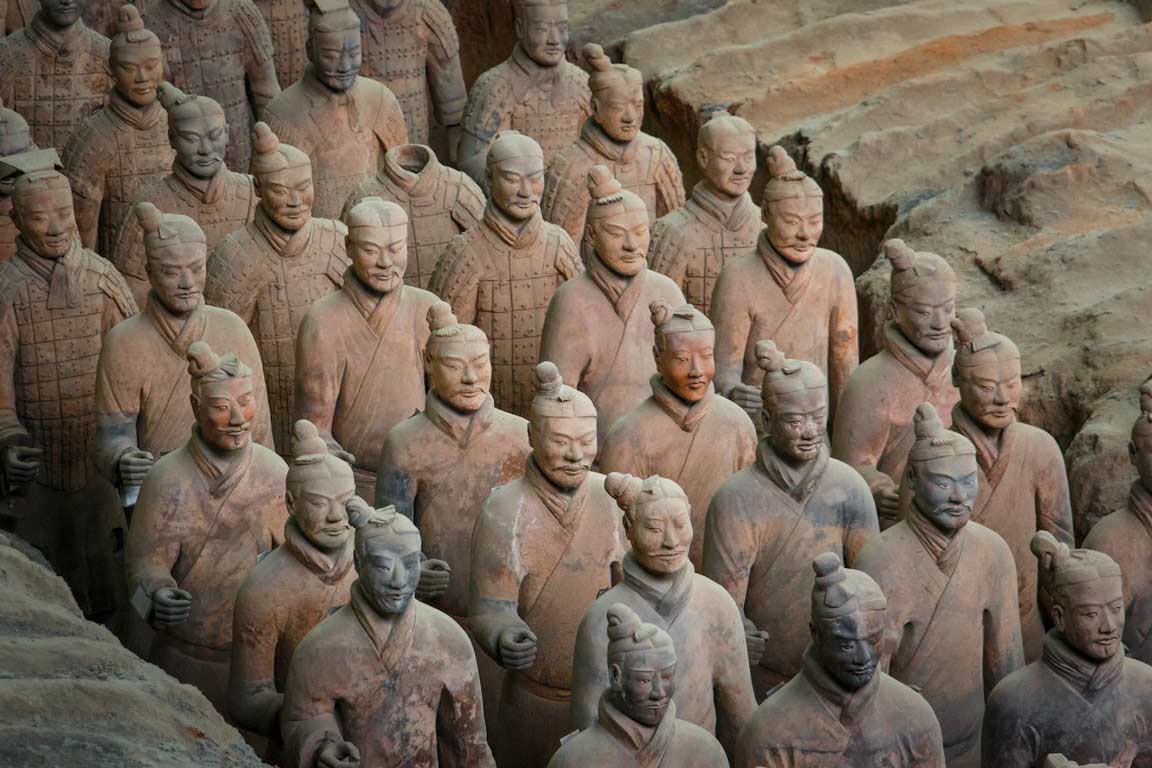
The Terracotta Army is one of the most astonishing archaeological discoveries of all time. It is a vast collection of life-sized terracotta warriors, horses, and chariots, buried with the First Emperor of China, Qin Shi Huang.
In this article, we will embark on a fascinating journey to explore the interesting history behind this extraordinary archaeological wonder and UNESCO world heritage site. So, let’s dive in!
The Terracotta Army was discovered in the city of Xi’an, a place steeped in history and cultural significance. Nestled within the outskirts of Xi’an, this archaeological wonder finds its home in the awe-inspiring Mausoleum of the First Qin Emperor.
Xi’an, as the fortunate host of this historical treasure, showcases the grandeur of ancient China through the magnificent Terracotta Army. But the terracotta army isn’t the only incredible ancient landmark in Xi’an, the city is in fact home to 6 Unesco world heritage sites! If you would like to find out more about those click here.
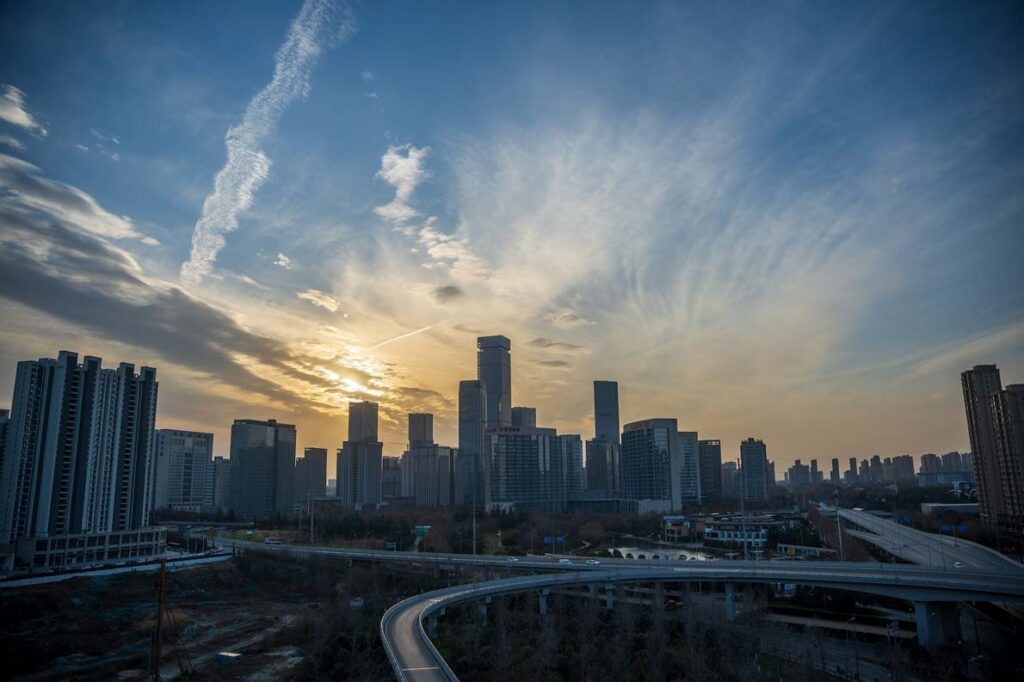
The Terracotta Army was by a group of local farmers who were digging a well. The farmers, Yang Zhifa, his five brothers, and their neighbor Wang Puzhi, were digging about a meter down when they struck hard red earth. Underneath, they found life-size terracotta heads and a few bronze arrowheads. They reported their find to the local authorities, and archaeologists soon began excavating the site.
The farmers who discovered the Terracotta Army were not aware of the historical significance of their find. They simply thought they had found some old pottery. However, their discovery turned out to be one of the most important archaeological finds in Chinese history.
The Terracotta Army’s discovery occurred in 1974 when the farmers happened upon the clay fragments. Since then, ongoing excavations have continued to reveal the vast magnitude and historical significance of this remarkable site.
The discovery of the Terracotta Army brought Xi’an an already famous city in China into the spotlight of archaeological and historical research worldwide! Its discovery was a monumental find that changed our understanding of ancient China and the remarkable achievements of its early civilizations.
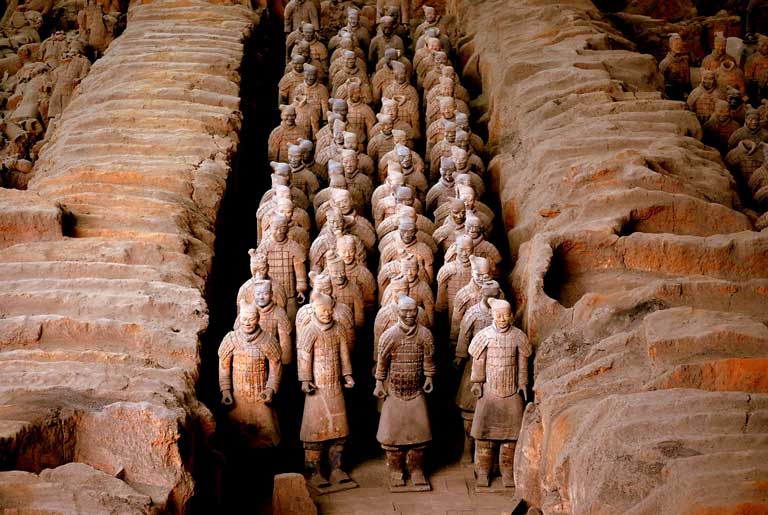
It was built under the leadership of China’s First Emperor, Qin Shi Huang. The Terracotta Army stands as a testament to the ingenuity and artistry of ancient Chinese craftsmen. The project was part of the emperor’s grand vision to protect himself in the afterlife and to showcase the might of the Qin Dynasty.
Qin Shi Huang, whose birth name was Ying Zheng, ascended the throne at the age of just 13 and embarked on an ambitious quest to consolidate various warring states into a unified China. His successful endeavour marked the beginning of the imperial era, where China’s vast territory and diverse cultures were brought under centralized rule.
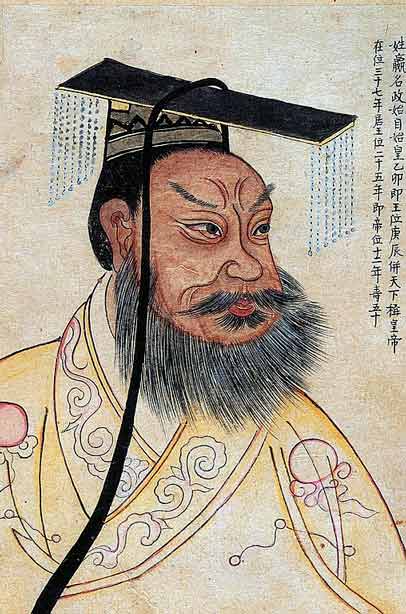
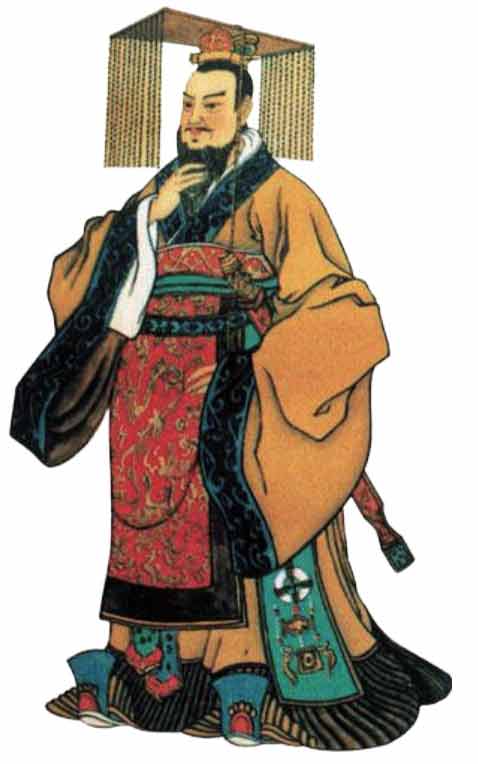
Construction of the Terracotta Army commenced in 246 BCE, during the reign of China’s first emperor, Qin Shi Huang, and was finished in 208 BCE. The ambitious project spanned around 38 years and involved the dedicated efforts of approximately 700,000 artisans and laborers to create these life-sized warriors.
The construction process itself was a remarkable feat of engineering and organization. The vast workforce, comprising skilled artisans, laborers, and craftsmen, worked tirelessly to fulfill the emperor’s vision of an awe-inspiring afterlife army. The artisans meticulously sculpted each soldier with unique facial features, hairstyles, and weaponry, ensuring that no two warriors were identical.
The assembly of the Terracotta Army involved a fascinating level of coordination and planning. The craftsmen created the warriors in various specialized workshops within the mausoleum complex. Once completed, the life-sized statues were carefully transported to their designated pits, where they stood in perfect formation.
As we previously mentioned the Terracotta Army was built under the ambitious vision of China’s First Emperor, Qin Shi Huang. His primary purpose was to ensure his eternal protection and grandeur in the afterlife.
The clay figures served as an eternal guard for the emperor in the afterlife, representing essential soldiers in his army, tasked with protecting and accompanying him into the realm beyond.
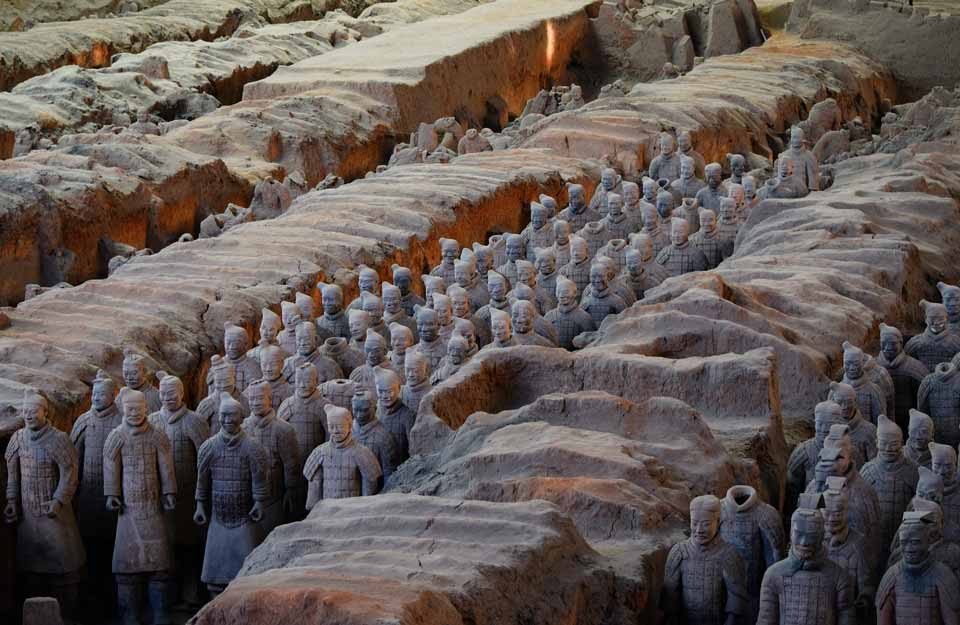
The Terracotta Army is composed of an estimated 8,000 life-sized terracotta warriors! Each of these remarkable figures bears distinct facial features, hairstyles, and weaponry, making them unique masterpieces in their own right.
The sight of the vast army of terracotta soldiers, arranged in precise military formations, is awe-inspiring. Each warrior represents a piece of ancient history, capturing the essence of the Qin Dynasty’s military might and artistic achievements.
The Terracotta Army, with its estimated 8,000 life-sized terracotta warriors, is strategically distributed across three massive pits. Each pit offers a glimpse into the military organization and the distinct roles of the soldiers.
The largest and most significant pit, Pit 1, houses approximately 6,000 terracotta soldiers. These warriors are organized in precise battle formations, presenting an overwhelming spectacle that leaves visitors in awe of their scale and precision.
Pit 1 provides a glimpse into the grandeur and scale of the ancient Chinese army. The soldiers stand ready for battle, armed with weapons ranging from bows and arrows to swords and spears. The level of detail in their uniforms and equipment showcases the meticulous craftsmanship of the artisans who sculpted them.
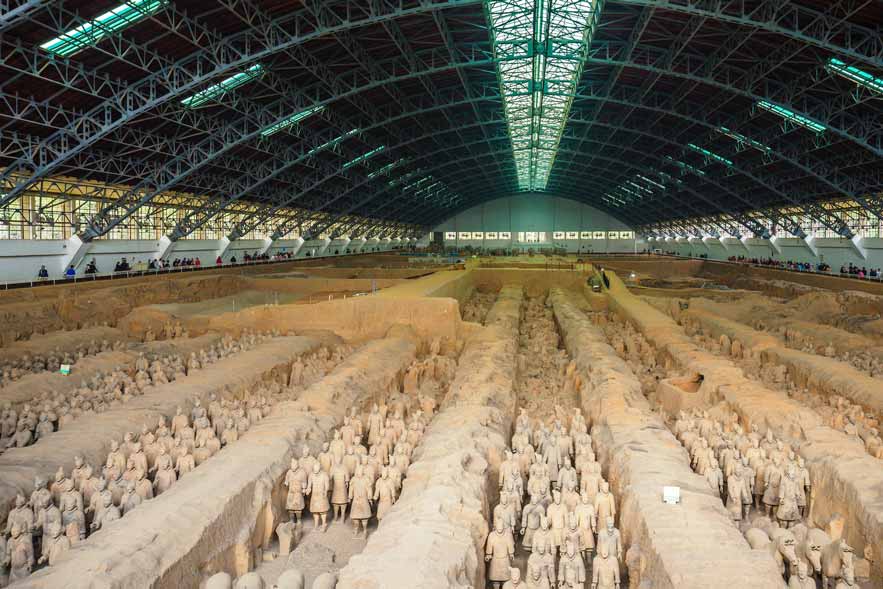
Pit 2, located adjacent to Pit 1, is home to around 1,400 warriors, along with war chariots and cavalry units. Here, the meticulous tactical organization of the ancient Chinese army is on full display, providing valuable insights into military strategy.
Pit 2 is a testament to the strategic prowess of the Qin Dynasty’s military. The chariots and cavalry units, arranged with precision, offer valuable insights into ancient Chinese warfare and the military tactics employed by Qin Shi Huang’s forces.

Although smaller in size, Pit 3 is no less remarkable. This pit contains 68 soldiers, showcasing the attention to detail and dedication to creating an enduring legacy and control system within the mausoleum complex.
Pit 3 provides a glimpse into the command center for the rest of the forces in pits 1 and 2 and would have assisted with the decision-making. These soldiers served important roles in the military structure and are presented with equal attention to detail as their counterparts in the larger pits.
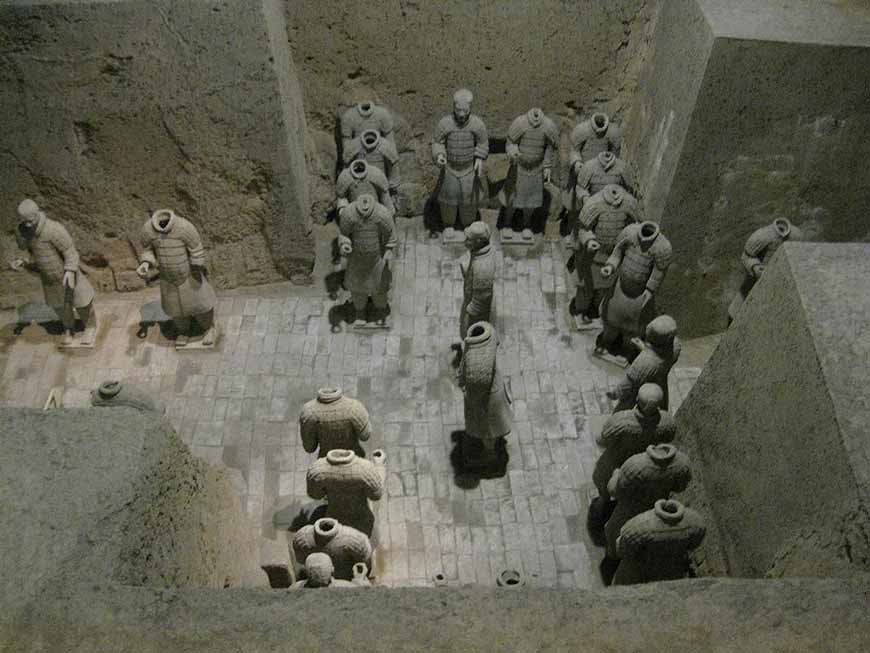
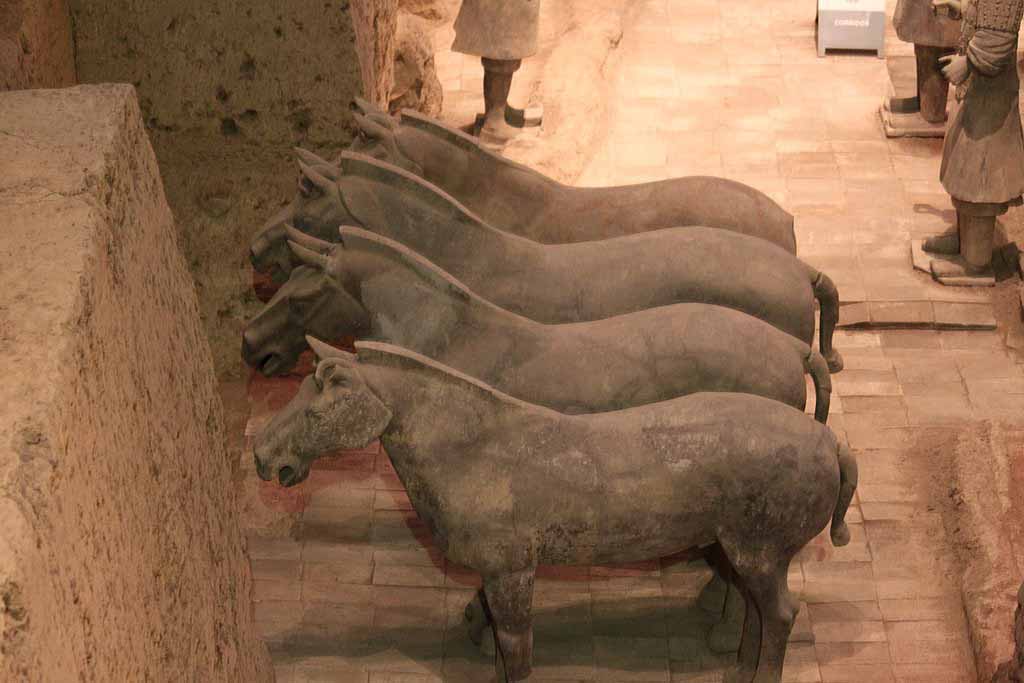
At the heart of the mausoleum complex stands the burial mound of the First Qin Emperor, a towering structure that rises to a height of approximately 76 meters. The mound, covered with lush vegetation, has remained unexplored to preserve its historical integrity. Believed to contain the emperor’s tomb and a treasure trove of precious artifacts, the burial mound remains an enigma, shrouded in mystery and reverence.
The burial mound is an architectural wonder and a symbol of the emperor’s lasting legacy. Its imposing height, concealed by the lush greenery, adds an air of mystery to the mausoleum complex. To this day, the interior of the burial mound remains unexplored, as excavation efforts are balanced with the preservation of historical heritage.
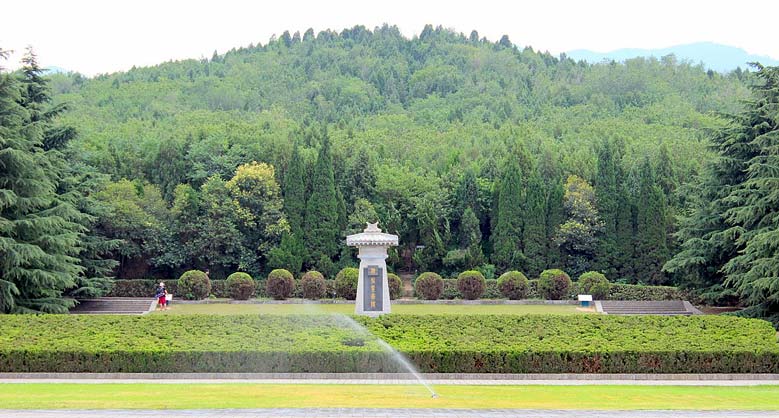
In addition to the well-known pits housing the Terracotta Army, another remarkable discovery was made within the mausoleum complex – Pit K0006. This pit, located to the northwest of the burial mound, contains an array of impressive bronze chariots, horses, and civil officials symbolizing the emperor’s journey to the afterlife. These intricately crafted chariots were found in a state of remarkable preservation, offering a glimpse into the extraordinary craftsmanship of the Qin Dynasty.
Pit K0006 showcases the significance of chariots in ancient Chinese funerary practices. The exquisite bronze chariots and horses served as a means of transportation for the emperor in the afterlife, reflecting the emperor’s status and the grandeur of his final journey.
In addition to the historical marvels found within the mausoleum complex, visitors can explore the vast Qin Shi Huang Mausoleum Site Museum, a designated UNESCO World Heritage Site. The Museum not only preserves the historical significance of the terracotta warriors but also provides insight into the rich cultural heritage of ancient China.
The Qin Shi Huang Mausoleum Site Museum also features a park with a sprawling landscape that encapsulates the essence of ancient China. Visitors can wander through the park’s scenic areas, which encompass historical relics, beautifully landscaped gardens, and informative exhibits. The park serves as a reminder of the deep-rooted traditions and contributions of ancient Chinese civilization to the world’s cultural heritage.
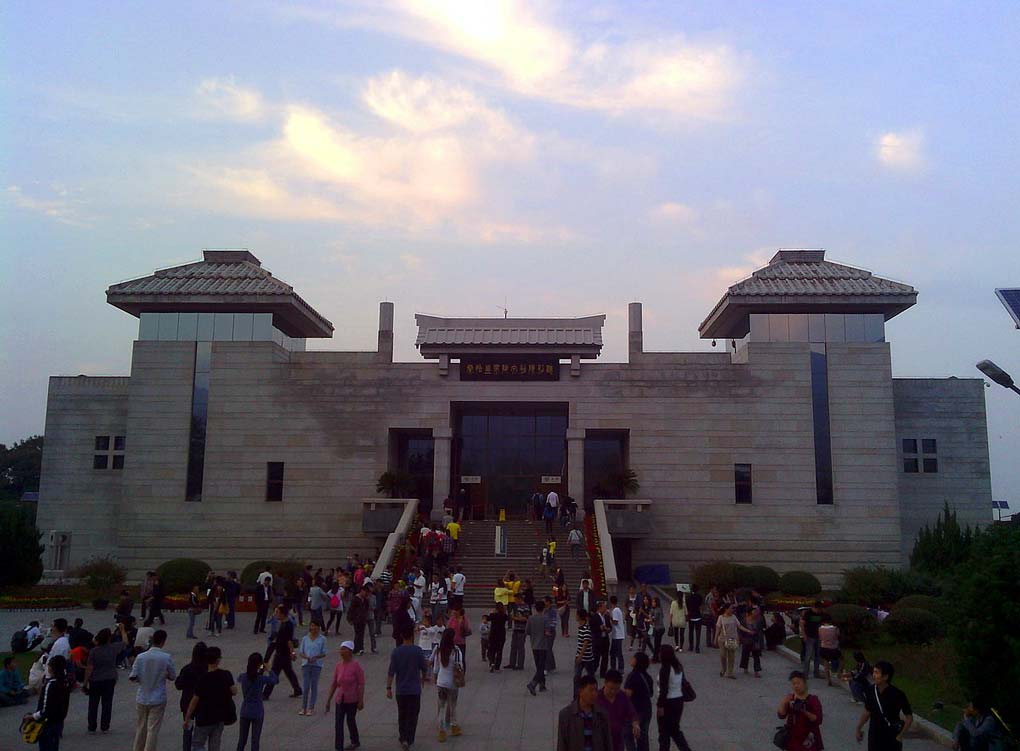
In conclusion, the Terracotta Army stands not only as a marvel of ancient engineering but also as a poignant reminder of the rich tapestry of history that continues to shape our world today. So, if you ever find yourself in Xi’an, take the time to walk among the clay soldiers and immerse yourself in the mysteries of China’s ancient past. Explore the mausoleum complex, for it holds the secrets of a legendary ruler who left an indelible mark on history and an eternal legacy of awe-inspiring wonders.
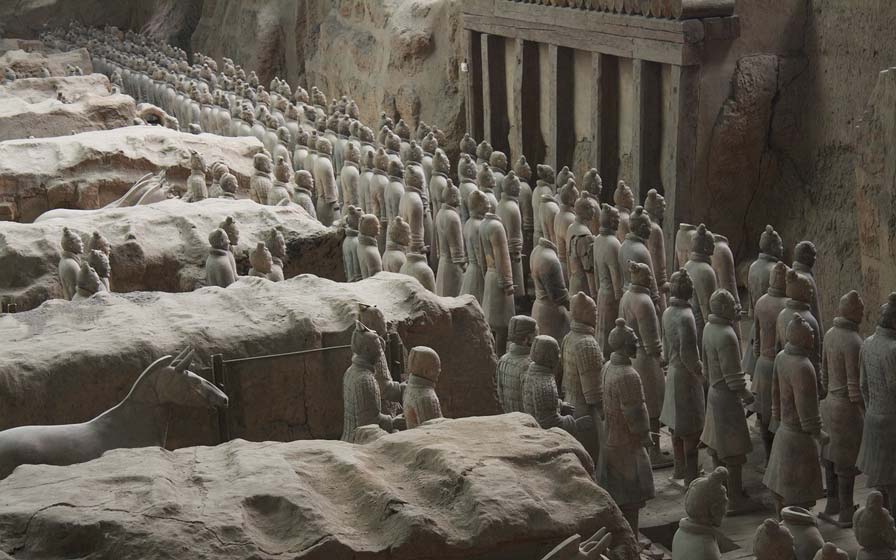
Related Articles:
Xi’an FAQs: Exploring China’s Ancient Capital City!
18 Qin Shi Huang Facts! [Explained]
Exploring the 6 UNESCO World Heritage Sites in Xi’an!
Top 21 Facts about The Terracotta Army you need to know!
UNESCO World Heritage Sites: The Ultimate Guide!
China’s UNESCO World Heritage Sites: A Complete A-Z List!